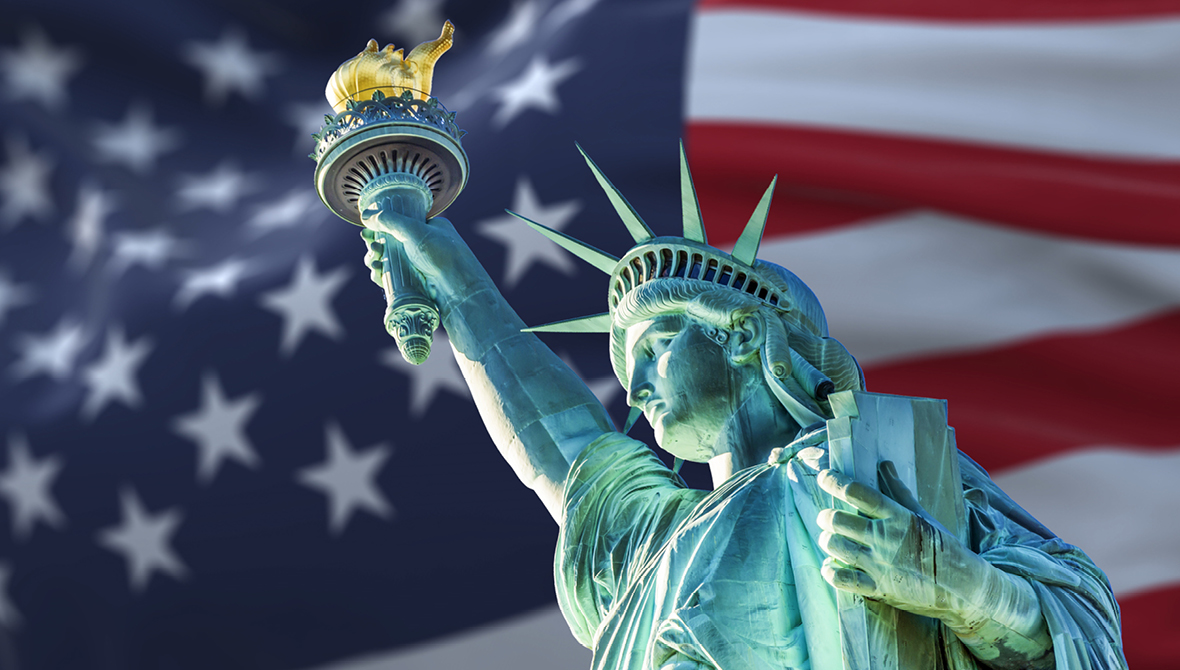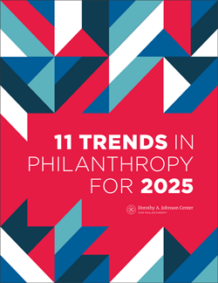The Movement to Fund Democracy is Learning Important Lessons


 This article was first published in our 11 Trends in Philanthropy for 2025 report. Explore the full report here.
This article was first published in our 11 Trends in Philanthropy for 2025 report. Explore the full report here.
Want the latest trends, research, and more delivered right to your inbox? Subscribe to the Johnson Center email newsletter.
Philanthropy has always been a pillar of civil society. But in recent years, a surging number of funders are making investments in the very threads that tie together the U.S. social fabric, such as voting rights and access, free and fair elections, an informed citizenry, and civil public discourse. In other words, philanthropy is investing heavily in making our democracy work.
Researchers and journalists noted that interest in U.S grantmaking to democracy-related 501(c)(3) nonprofits began increasing during the 2016 presidential election cycle when there was evidence of election interference activity from Russia (Daniels, 2024, para.4; Griffin et al., 2024). “Foundations, fiscal sponsors, donor-advised funds, and other grantmakers spent $9.7 billion on democracy efforts in 2022, nearly twice the total from 2018” (Lindsay, 2024a, para. 15). While totals from the 2024 election cycle are not available as of this writing, all indications are that the upward trend of democracy funding continued in 2024, especially with toxic polarization in a deeply divided America at an all-time high (Council on Foundations, 2024). [See sidebar.]
According to The Chronicle of Philanthropy, there hasn’t been much analysis of the pro-democracy movement — “its funding, its key players, its challenges and opportunities,” let alone its true impact on healing our divides (Lindsay, 2024a, para. 5). But we are beginning to see major efforts to improve how these countless disparate players approach and coordinate the work.
Eight years on from the turning point that was 2016, we’re seeing this subsector move past some of its early growing pains and towards a more sophisticated, coordinated, and responsive approach to action.
Most nonprofits and foundations are used to setting their own timelines — for grant cycles and evaluations, for major events and milestones. But organizations entering the democracy space — be they civic groups, foundations, or nonprofit media — must contend with the opposite dynamic. Democracy has its own timelines — election cycles, voter registration deadlines, etc. — that democracy funding and programs must be responsive to. Ensuring that funding is both steady and received in time to make an impact are important criteria for funders to consider and plan for.
In previous election cycles, funding for non-partisan, election-related activities accelerated in presidential election years and often subsided in the years that followed, creating an inefficient and ineffective “boom-and-bust cycle” that wreaks havoc for organizations on the ground (Democracy Funders Network, n.d., para. 6). Additionally, funders have often made grants to support organizations too late in an election cycle to be of much use.
Long-time funders are trying to smooth out this rollercoaster and bring newer funders onboard. For instance, in 2024, Democracy Fund launched the “All by April” campaign to encourage funders to disburse support more quickly to resource organizations well before the November 2024 election (para. 1). More than 170 foundations, advisors, and donors signed on, rapidly moving money to organizations ahead of the traditional summer and fall get-out-the-vote seasons (Henry, 2024). As Ali Noorani of the William and Flora Hewlett Foundation said in The Chronicle of Philanthropy, “We have to be thinking beyond election cycles, … This is a long-term body of work” (Lindsay, 2024c, para. 6).
The flood of new funders, actors, and philanthropic infrastructure organizations entering the democracy space has created both dynamism and, at times, a confusing ecosystem of local, regional, and national players approaching the issue from a multitude of angles. To bring visibility and coordination to this work, three new digital platforms launched in the fall of 2024 alone.
In September, Impala launched the U.S. Democracy Hub with support from the Democracy Funders Network (Brukner, 2024). The platform shares funding data and identifies organizations in the democracy space, tracking some 4,000 nonprofits and 25,000 funders, drawing on IRS data for both grantmakers and nonprofits, and capturing not just institutional donors, but also donor-advised funds (DAFs) and individuals.
In October, the National Civic League launched the Healthy Democracy Ecosystem Map to identify nonprofits, funders, and community groups across the country working on democracy efforts, to facilitate collaboration, and to serve as a resource, particularly for place-based funders (Lindsay, 2024a).
Despite the national importance of these efforts, access to civic opportunities and democracy funding is far from equal. Researchers at Johns Hopkins’ SNF Agora Institute created a “heat map” of opportunities for civic engagement across the country, layering information about nonprofits and public data from the U.S. Census Bureau to better understand where and whether Americans have access to civic infrastructure (De Vries et al., 2023, para. 2). “Civic opportunity scores per capita decreased as poverty levels increase” in census tracts across the country, the researchers found, “and wealthier, whiter, better-educated communities were more likely to have civic opportunity” (para. 6).
On top of fewer civic opportunities, there are also disparities in funding for the nonprofits engaged in this work, creating a cyclic pattern of civic deserts. The Council on Foundations (2024) reported that the U.S. South and small, rural communities saw the least investment from the grantmakers they surveyed. As getting people to engage in politics — at the local, state, or national level — is essential to a strong democracy, any funding gaps can have a cascading set of effects.
While much remains uncertain, it’s clear that it will take continued and increased investment from a wider swath of the sector to strengthen democracy and build bridges in the coming years.
An October 2024 New York Times/Siena College poll of 2,516 likely voters found that 76% said American democracy was currently under threat, and 45% felt the U.S. political system did not do a good job representing the people. Even the word, “democracy” has become partisan. The organization Philanthropy for Active Civic Engagement (PACE) found that while 82% of Democrats responded positively to the word, that was only true for 66% of Independents and 64% of Republicans (Lindsay, 2024b).
Brukner, S. (2024, September 18). Introducing the U.S. Democracy Hub: A groundbreaking resource for the democracy sector. Impala. https://impala.digital/blog/u.s.-democracy-hub-launch
Civic Information Index. (2024). About the Civic Information Index. https://civicinfoindex.org/about/
Council on Foundations. (2024). Coming together, not apart: How philanthropy supports connection in a time of dangerous division. https://cof.org/content/coming-together-not-apart
Daniels, A. (2024, July 11). As ‘pro-democracy’ philanthropy grows, experts warn of many obstacles to combating misinformation. The Chronicle of Philanthropy. https://www.philanthropy.com/article/as-pro-democracy-philanthropy-grows-experts-warn-of-many-obstacles-to-combating-misinformation
De Vries, M., Han, Y., & Kim, H. (2023). Civic engagement and inequality in America. Johns Hopkins SNF Agora Institute. https://snfagora.jhu.edu/publication/the-unequal-landscape-of-civic-opportunity-in-america/
Democracy Funders Network. (2024). What Election Day to every day means to us. https://www.democracyfundersnetwork.org/resources/2024/10/21/what-election-day-to-every-day-means-to-us
Griffin, R., Lobeck, C, Botero, M. Cooper, S, Diggles, M., McKay, C., & Steffen, E. (2024, January). Field in focus: The state of pro-democracy institutional philanthropy. Democracy Fund. https://democracyfund.org/idea/field-in-focus-the-state-of-pro-democracy-institutional-philanthropy/
Henry, S. (2024, May 8). Democracy donors rally to fund election-related work well before November. Inside Philanthropy. https://www.insidephilanthropy.com/home/2024-5-8-democracy-donors-push-to-fund-groups-well-before-election-day
Impala. (2024). U.S. Democracy Hub. https://impala.digital/democracy
Lindsay, D. (2024a, October 7). How much is philanthropy spending toward a more perfect union? The Chronicle of Philanthropy. https://www.philanthropy.com/commons/philanthropy-funding-democracy
Lindsay, D. (2024b, October 24). What to say on November 7 and how to say it. The Chronicle of Philanthropy. https://www.philanthropy.com/commons/civic-language-philanthropy?
Lindsay, D. (2024c, November 6). The day after: Inside a quiet billion-dollar election effort. The Chronicle of Philanthropy. https://www.philanthropy.com/commons/election-trust-nonprofits-philanthropy
The New York Times. (2024, October 25). Cross-Tabs: Late October 2024 Times/Siena Poll of the likely electorate. https://www.nytimes.com/interactive/2024/10/27/us/elections/times-siena-poll-crosstabs.html